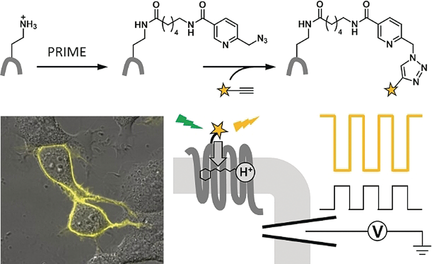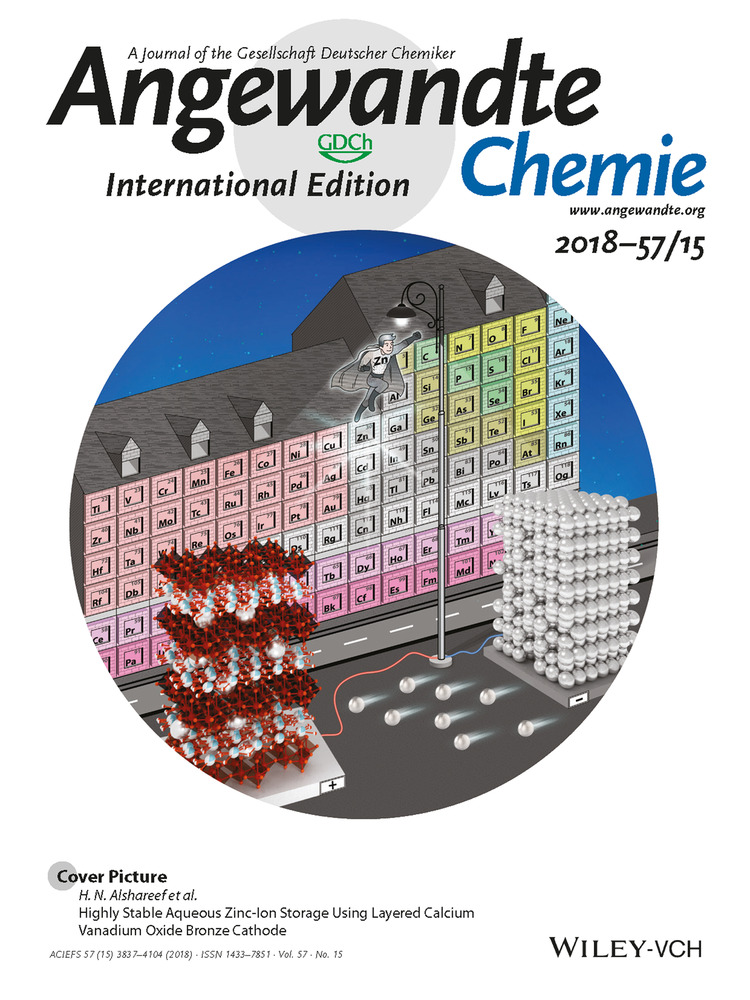Hybrid Indicators for Fast and Sensitive Voltage Imaging
Correction(s) for this article
-
Corrigendum: Hybrid Indicators for Fast and Sensitive Voltage Imaging
- Yongxian Xu,
- Luxin Peng,
- Sicong Wang,
- Anqi Wang,
- Ruirui Ma,
- Ying Zhou,
- Jiahe Yang,
- De-en Sun,
- Wei Lin,
- Xing Chen,
- Peng Zou,
- Volume 58Issue 43Angewandte Chemie International Edition
- pages: 15183-15183
- First Published online: October 14, 2019
Yongxian Xu
College of Chemistry and Molecular Engineering, Synthetic and Functional Biomolecules Center, Beijing National Laboratory for Molecular Sciences, Key Laboratory of Bioorganic Chemistry and Molecular Engineering of Ministry of Education, Peking University, Beijing, 100871 China
Peking-Tsinghua Center for Life Sciences, Beijing, 100871 China
School of Life Sciences, Tsinghua University, Beijing, 100084 China
These authors contributed equally to this work.
Search for more papers by this authorLuxin Peng
College of Chemistry and Molecular Engineering, Synthetic and Functional Biomolecules Center, Beijing National Laboratory for Molecular Sciences, Key Laboratory of Bioorganic Chemistry and Molecular Engineering of Ministry of Education, Peking University, Beijing, 100871 China
These authors contributed equally to this work.
Search for more papers by this authorSicong Wang
College of Chemistry and Molecular Engineering, Synthetic and Functional Biomolecules Center, Beijing National Laboratory for Molecular Sciences, Key Laboratory of Bioorganic Chemistry and Molecular Engineering of Ministry of Education, Peking University, Beijing, 100871 China
These authors contributed equally to this work.
Search for more papers by this authorAnqi Wang
College of Chemistry and Molecular Engineering, Synthetic and Functional Biomolecules Center, Beijing National Laboratory for Molecular Sciences, Key Laboratory of Bioorganic Chemistry and Molecular Engineering of Ministry of Education, Peking University, Beijing, 100871 China
Peking-Tsinghua Center for Life Sciences, Beijing, 100871 China
These authors contributed equally to this work.
Search for more papers by this authorRuirui Ma
College of Chemistry and Molecular Engineering, Synthetic and Functional Biomolecules Center, Beijing National Laboratory for Molecular Sciences, Key Laboratory of Bioorganic Chemistry and Molecular Engineering of Ministry of Education, Peking University, Beijing, 100871 China
Search for more papers by this authorYing Zhou
College of Chemistry and Molecular Engineering, Synthetic and Functional Biomolecules Center, Beijing National Laboratory for Molecular Sciences, Key Laboratory of Bioorganic Chemistry and Molecular Engineering of Ministry of Education, Peking University, Beijing, 100871 China
Search for more papers by this authorJiahe Yang
College of Chemistry and Molecular Engineering, Synthetic and Functional Biomolecules Center, Beijing National Laboratory for Molecular Sciences, Key Laboratory of Bioorganic Chemistry and Molecular Engineering of Ministry of Education, Peking University, Beijing, 100871 China
MRC Human Immunology Unit, Weatherall Institute of Molecular Medicine, University of Oxford, Oxford, Oxfordshire, OX3 9DS UK
Search for more papers by this authorDe-en Sun
College of Chemistry and Molecular Engineering, Synthetic and Functional Biomolecules Center, Beijing National Laboratory for Molecular Sciences, Key Laboratory of Bioorganic Chemistry and Molecular Engineering of Ministry of Education, Peking University, Beijing, 100871 China
Search for more papers by this authorDr. Wei Lin
College of Chemistry and Molecular Engineering, Synthetic and Functional Biomolecules Center, Beijing National Laboratory for Molecular Sciences, Key Laboratory of Bioorganic Chemistry and Molecular Engineering of Ministry of Education, Peking University, Beijing, 100871 China
Search for more papers by this authorProf. Dr. Xing Chen
College of Chemistry and Molecular Engineering, Synthetic and Functional Biomolecules Center, Beijing National Laboratory for Molecular Sciences, Key Laboratory of Bioorganic Chemistry and Molecular Engineering of Ministry of Education, Peking University, Beijing, 100871 China
Peking-Tsinghua Center for Life Sciences, Beijing, 100871 China
Search for more papers by this authorCorresponding Author
Prof. Dr. Peng Zou
College of Chemistry and Molecular Engineering, Synthetic and Functional Biomolecules Center, Beijing National Laboratory for Molecular Sciences, Key Laboratory of Bioorganic Chemistry and Molecular Engineering of Ministry of Education, Peking University, Beijing, 100871 China
Peking-Tsinghua Center for Life Sciences, Beijing, 100871 China
PKU-IDG/McGovern Institute for Brain Research, Beijing, 100871 China
Search for more papers by this authorYongxian Xu
College of Chemistry and Molecular Engineering, Synthetic and Functional Biomolecules Center, Beijing National Laboratory for Molecular Sciences, Key Laboratory of Bioorganic Chemistry and Molecular Engineering of Ministry of Education, Peking University, Beijing, 100871 China
Peking-Tsinghua Center for Life Sciences, Beijing, 100871 China
School of Life Sciences, Tsinghua University, Beijing, 100084 China
These authors contributed equally to this work.
Search for more papers by this authorLuxin Peng
College of Chemistry and Molecular Engineering, Synthetic and Functional Biomolecules Center, Beijing National Laboratory for Molecular Sciences, Key Laboratory of Bioorganic Chemistry and Molecular Engineering of Ministry of Education, Peking University, Beijing, 100871 China
These authors contributed equally to this work.
Search for more papers by this authorSicong Wang
College of Chemistry and Molecular Engineering, Synthetic and Functional Biomolecules Center, Beijing National Laboratory for Molecular Sciences, Key Laboratory of Bioorganic Chemistry and Molecular Engineering of Ministry of Education, Peking University, Beijing, 100871 China
These authors contributed equally to this work.
Search for more papers by this authorAnqi Wang
College of Chemistry and Molecular Engineering, Synthetic and Functional Biomolecules Center, Beijing National Laboratory for Molecular Sciences, Key Laboratory of Bioorganic Chemistry and Molecular Engineering of Ministry of Education, Peking University, Beijing, 100871 China
Peking-Tsinghua Center for Life Sciences, Beijing, 100871 China
These authors contributed equally to this work.
Search for more papers by this authorRuirui Ma
College of Chemistry and Molecular Engineering, Synthetic and Functional Biomolecules Center, Beijing National Laboratory for Molecular Sciences, Key Laboratory of Bioorganic Chemistry and Molecular Engineering of Ministry of Education, Peking University, Beijing, 100871 China
Search for more papers by this authorYing Zhou
College of Chemistry and Molecular Engineering, Synthetic and Functional Biomolecules Center, Beijing National Laboratory for Molecular Sciences, Key Laboratory of Bioorganic Chemistry and Molecular Engineering of Ministry of Education, Peking University, Beijing, 100871 China
Search for more papers by this authorJiahe Yang
College of Chemistry and Molecular Engineering, Synthetic and Functional Biomolecules Center, Beijing National Laboratory for Molecular Sciences, Key Laboratory of Bioorganic Chemistry and Molecular Engineering of Ministry of Education, Peking University, Beijing, 100871 China
MRC Human Immunology Unit, Weatherall Institute of Molecular Medicine, University of Oxford, Oxford, Oxfordshire, OX3 9DS UK
Search for more papers by this authorDe-en Sun
College of Chemistry and Molecular Engineering, Synthetic and Functional Biomolecules Center, Beijing National Laboratory for Molecular Sciences, Key Laboratory of Bioorganic Chemistry and Molecular Engineering of Ministry of Education, Peking University, Beijing, 100871 China
Search for more papers by this authorDr. Wei Lin
College of Chemistry and Molecular Engineering, Synthetic and Functional Biomolecules Center, Beijing National Laboratory for Molecular Sciences, Key Laboratory of Bioorganic Chemistry and Molecular Engineering of Ministry of Education, Peking University, Beijing, 100871 China
Search for more papers by this authorProf. Dr. Xing Chen
College of Chemistry and Molecular Engineering, Synthetic and Functional Biomolecules Center, Beijing National Laboratory for Molecular Sciences, Key Laboratory of Bioorganic Chemistry and Molecular Engineering of Ministry of Education, Peking University, Beijing, 100871 China
Peking-Tsinghua Center for Life Sciences, Beijing, 100871 China
Search for more papers by this authorCorresponding Author
Prof. Dr. Peng Zou
College of Chemistry and Molecular Engineering, Synthetic and Functional Biomolecules Center, Beijing National Laboratory for Molecular Sciences, Key Laboratory of Bioorganic Chemistry and Molecular Engineering of Ministry of Education, Peking University, Beijing, 100871 China
Peking-Tsinghua Center for Life Sciences, Beijing, 100871 China
PKU-IDG/McGovern Institute for Brain Research, Beijing, 100871 China
Search for more papers by this authorGraphical Abstract
The fast and the sensitive: A hybrid strategy employing site-specific protein modification techniques produced a palette of fluorescent membrane voltage indicators with sub-millisecond response kinetics. These indicators enable the optical mapping of electrical communications among cells at high resolution.
Abstract
Membrane voltage is an important biophysical signal that underlies intercellular electrical communications. A fluorescent voltage indicator is presented that enables the investigation of electrical signaling at high spatial resolution. The method is built upon the site-specific modification of microbial rhodopsin proteins with organic fluorophores, resulting in a hybrid indicator scaffold that is one of the most sensitive and fastest orange-colored voltage indicators developed to date. We applied this technique to optically map electrical connectivity in cultured cells, which revealed gap junction-mediated long-range coupling that spanned over hundreds of micrometers.
Supporting Information
As a service to our authors and readers, this journal provides supporting information supplied by the authors. Such materials are peer reviewed and may be re-organized for online delivery, but are not copy-edited or typeset. Technical support issues arising from supporting information (other than missing files) should be addressed to the authors.
| Filename | Description |
|---|---|
| anie201712614-sup-0001-misc_information.pdf2.2 MB | Supplementary |
| anie201712614-sup-0001-movS1.mp41.3 MB | Supplementary |
| anie201712614-sup-0001-movS2.avi11.8 MB | Supplementary |
Please note: The publisher is not responsible for the content or functionality of any supporting information supplied by the authors. Any queries (other than missing content) should be directed to the corresponding author for the article.
References
- 1A. E. Cohen, V. Venkatachalam, Annu. Rev. Biophys. 2014, 43, 211–232.
- 2M. V. Bennett, R. S. Zukin, Neuron 2004, 41, 495–511.
- 3S. Dhein, Trends Pharmacol. Sci. 1998, 19, 229–241.
- 4E. W. Miller, Curr. Opin. Chem. Biol. 2016, 33, 74–80.
- 5Y. Xu, P. Zou, A. E. Cohen, Curr. Opin. Chem. Biol. 2017, 39, 1–10.
- 6P. Zou, Y. Zhao, A. D. Douglass, D. R. Hochbaum, D. Brinks, C. A. Werley, D. J. Harrison, R. E. Campbell, A. E. Cohen, Nat. Commun. 2014, 5, 4625.
- 7Y. Gong, C. Huang, J. Z. Li, B. F. Grewe, Y. Zhang, S. Eismann, M. J. Schnitzer, Science 2015, 350, 1361–1366.
- 8Y. Gong, M. J. Wagner, J. Zhong Li, M. J. Schnitzer, Nat. Commun. 2014, 5, 3674.
- 9C. Uttamapinant, A. Tangpeerachaikul, S. Grecian, S. Clarke, U. Singh, P. Slade, K. R. Gee, A. Y. Ting, Angew. Chem. Int. Ed. 2012, 51, 5852–5856; Angew. Chem. 2012, 124, 5954–5958.
- 10C. Uttamapinant, M. I. Sanchez, D. S. Liu, J. Z. Yao, A. Y. Ting, Nat. Protoc. 2013, 8, 1620–1634.
- 11G. V. Los, L. P. Encell, M. G. McDougall, D. D. Hartzell, N. Karassina, C. Zimprich, M. G. Wood, R. Learish, R. F. Ohana, M. Urh, D. Simpson, J. Mendez, K. Zimmerman, P. Otto, G. Vidugiris, J. Zhu, A. Darzins, D. H. Klaubert, R. F. Bulleit, K. V. Wood, ACS Chem. Biol. 2008, 3, 373–382.
- 12A. Keppler, S. Gendreizig, T. Gronemeyer, H. Pick, H. Vogel, K. Johnsson, Nat. Biotechnol. 2003, 21, 86–89.
- 13P. Zou, A. Y. Ting, ACS Chem. Biol. 2011, 6, 308–313.
- 14P. Thomas, T. G. Smart, J. Pharmacol. Toxicol. Methods 2005, 51, 187–200.
- 15A. Sherman, J. Rinzel, Biophys. J. 1991, 59, 547–559.





